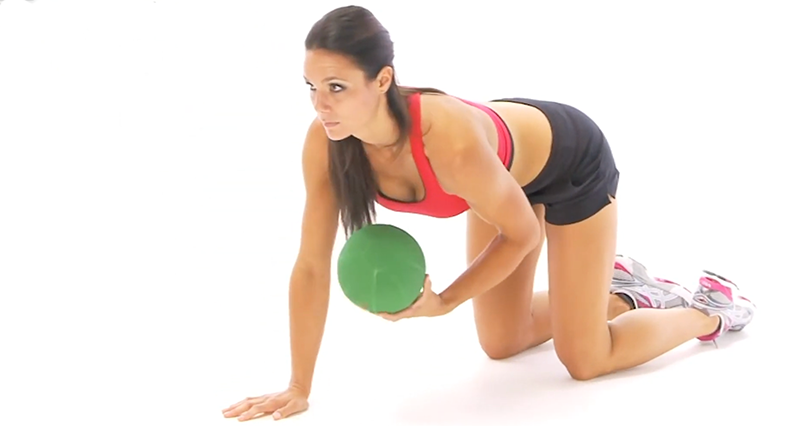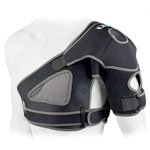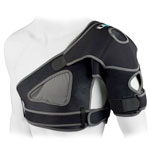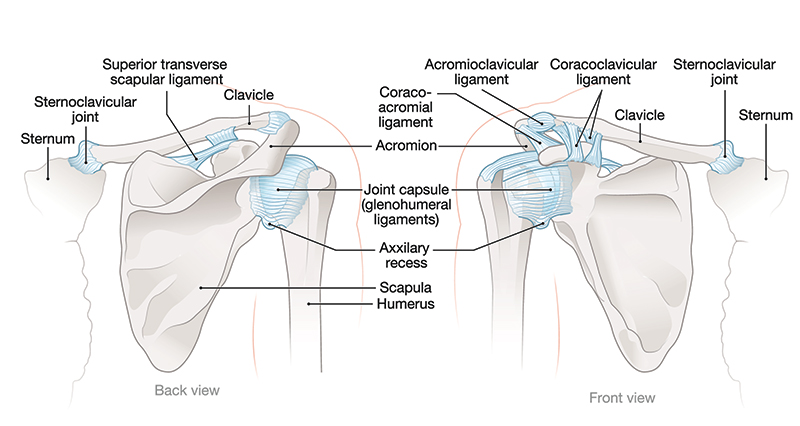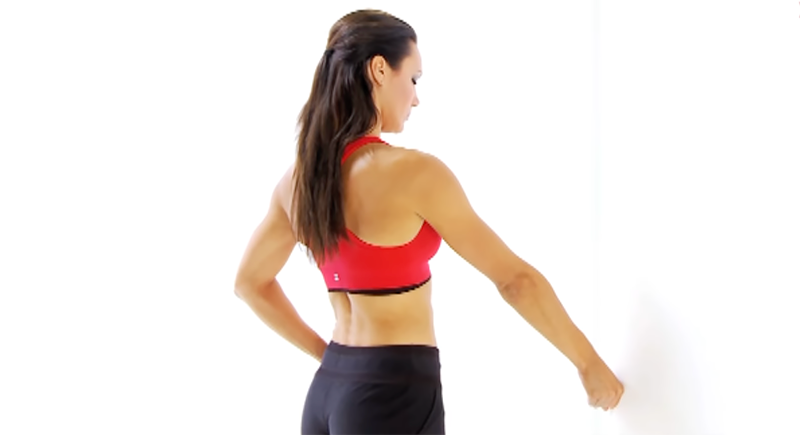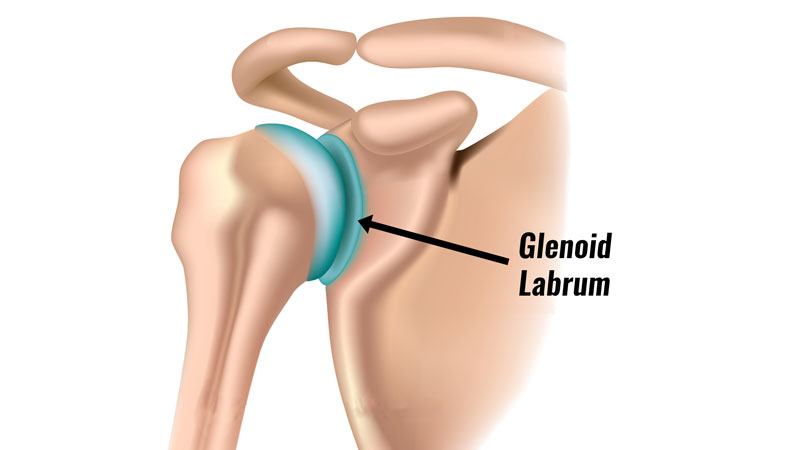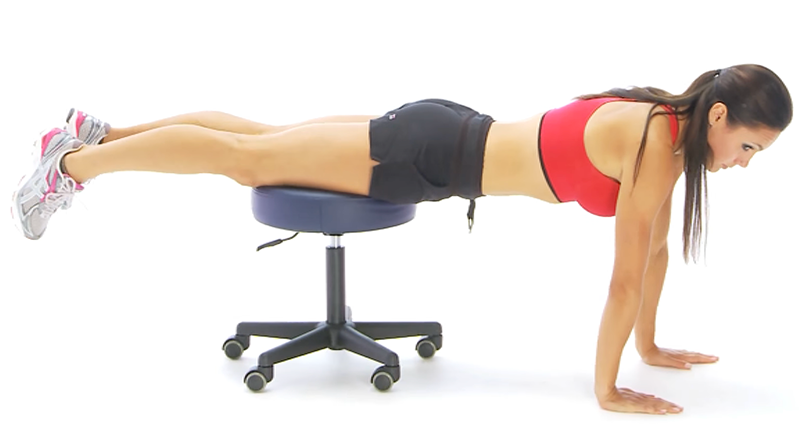Dynamic shoulder exercises involve movement and make up a large part of a shoulder rehabilitation program. Exercises can usually begin as soon as pain allows and in more severe shoulder injuries may follow isometric (static) shoulder strengthening exercises. Here we explain a range of shoulder rehabilitation exercises using resistance bands and dumbells.
Medial Rotation
The Medial Rotation exercise targets the muscles subscapularis, teres major, and latissimus dorsi.
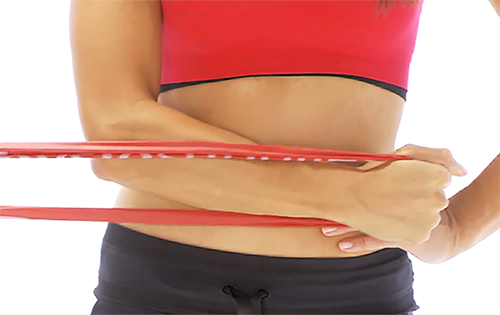
Teaching point:
- Start with the band attached to a fixed point on your side
- Hold the other end of the band in one hand, with the elbow bent and the upper arm by your side
- Keeping the elbow by your side, move your hand towards your stomach as far as is comfortable
- Slowly return to the starting position
Related Injuries
Pec Fly
Fly resistance band exercise strengthens the chest muscles. It is a great alternative to the resistance machine found in gyms, sometimes also known as a Pec Dec.
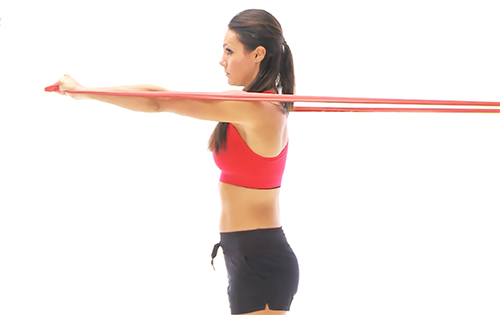
Teaching point:
- Attach the centre of the band to a stationary object behind you at chest height
- Hold an end in each hand and start with your arms out to the side, just below shoulder height
- Keep a small bend in the elbows as you bring your arms forward so that your hands meet in front of your chest
- Slowly return to the starting position
Related Injuries
Lateral Raise
The Lateral Raise exercise strengthens the deltoid muscle, the large one which covers the top of the shoulder joint. This exercise also targets the supraspinatus.
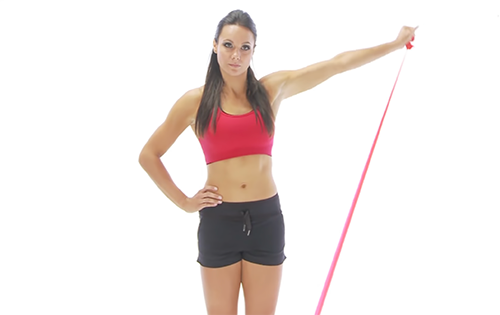
Teaching point:
- Hold one end of the band in one hand, and attach the other end to something sturdy on the other side of your body
- Start with your hand by your side and the band under slight tension
- Raise your arm out to the side to just above shoulder height
- Slowly return back to the starting position and repeat
Related injuries
Standing Chest Press
The Standing Chest Press strengthens the chest muscles, the pectoralis major and minor, as well as the front
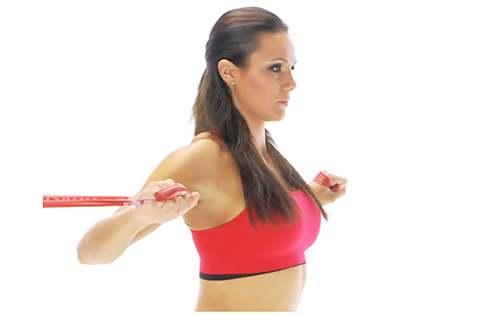
Teaching point:
- Attach the centre of the band to a stationary object and hold one end in each hand
- Stand with your back to the attachment, elbows bent and shoulders abducted to 90 degrees (upper arm level with shoulder) so that your hands are next to your chest
- Push forwards and straighten your arms out in front of you
- Slowly return to the starting position
Related Injuries
Wood Chops
The Wood Chop shoulder exercise improves upper body strength and explosive strength. This exercise strengthens the scapular muscles, core stabilizers, and triceps.
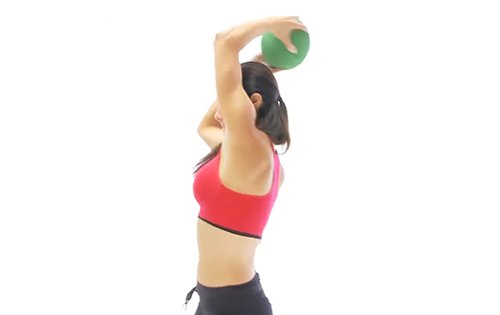
Teaching point:
- The athlete stands one meter in front of a rebound net with a medicine ball held in both hands, over one shoulder as shown
- The ball is thrown down into the net using a chopping motion
- The athlete catches the rebound, absorbs the impact and then repeats the throw
- This can also be performed using a partner to catch and return the ball and should be repeated on both sides
Medicine Ball Alphabet
This Medicine Ball drawing exercise strengthens the deltoid and the rotator cuff muscles, infraspinatus, supraspinatus, subscapularis, and teres minor muscles.
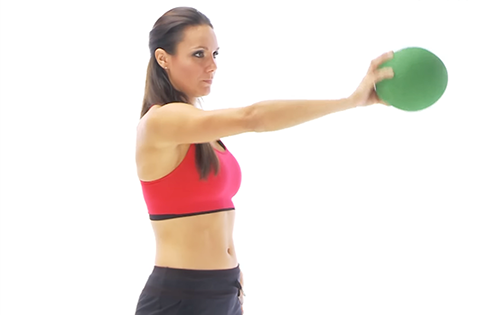
Teaching point:
- With the arm straight in front and slightly to the side, the athlete holds a small ball in the hand
- They then spell out the alphabet with the ball
90/90 Internal Rotation
Internal Rotation exercise uses a resistance band to strengthen the rotator cuff muscles and scapular muscles.
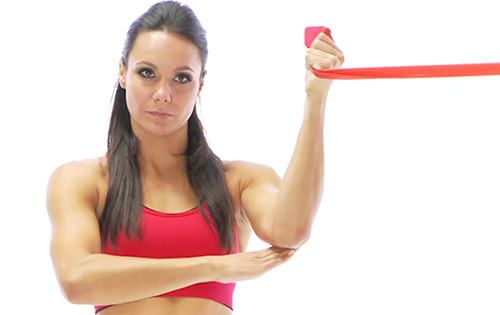
Teaching point:
- The athlete rotates the arm so that the forearm moves forwards, to a horizontal position
- They then slowly return to the starting position
- As strength develops the supporting hand can be removed
90/90 External Rotation
External Rotation exercise helps to strengthen the rotator cuff muscles.
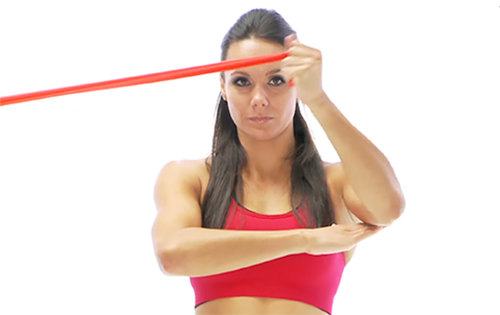
Teaching point:
- The resistance band is anchored in front and the other end is held in the hand, with the arm raised and elbow bent as shown
- The athlete rotates the arm so that the fist points upwards
- They then slowly return to the starting position and repeat
The Plyometric Push-Up
This Plyometric Push-Up exercise is great for improving upper body strength and explosive power. This exercise strengthens many muscles, including primary muscles, which are the deltoids, triceps, and pectoralis major.
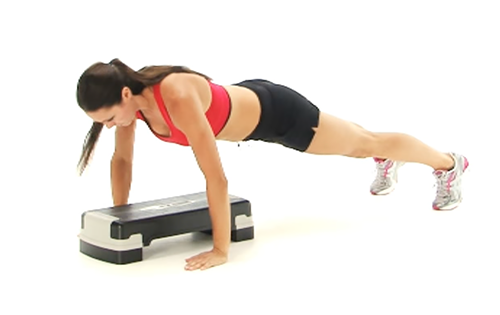
Teaching point:
- This can be performed as a wall push-up or on the floor
- The athlete assumes the push-up position, starting with the elbows bent
- The athlete pushes out with enough force so that the hands leave the surface of the wall or floor
Advanced version:
- Two boxes of 10-15cm height are placed on either side of the athlete
- The athlete starts with elbows bent and pushes upwards with enough force,
so the hands come off the floor and can be placed on the boxes
Shoulder Step Ups
This exercise in the extended press-up position places the shoulder blades into protraction, so increases muscle activation of the serratus anterior or punching muscle. This exercise strengthens the serratus anterior and triceps.
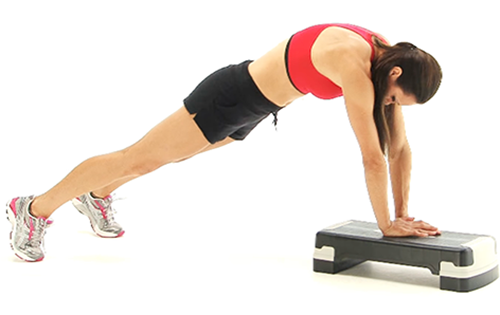
Teaching point:
- The athlete positions themselves ready for a push-up, with either the knees or feet on the floor, depending on the strength
- A step of 20-30cm is positioned next to the athlete
- They then raise one hand at a time onto the step, so that one is on top
- The back is then rounded upwards, similar to a cat stretch
Serratus Punch
The Serratus Punch exercise is designed to strengthen the shoulder blade protractors such as the serratus anterior.
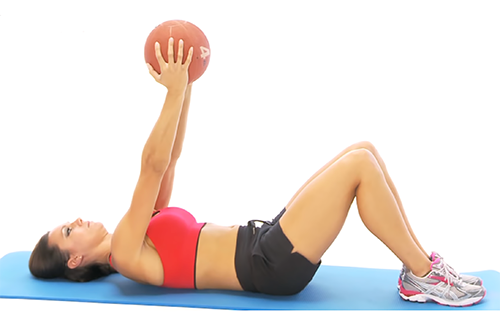
Teaching point:
- The athlete lies on their back with the arms pointing up, elbows straight and a medicine ball held between the hands
- The ball is pushed upwards by pushing the shoulder forwards and keeping the elbows straight
- Hold for 2 seconds, rest and repeat
Muscles Worked:
- Serratus Anterior
Seated Medicine Ball Rotation
The Medicine Ball Rotation shoulder exercise involves catching and throwing a ball, using internal shoulder rotation to strengthen the rotator cuff muscles and increase the explosive internal rotation strength.
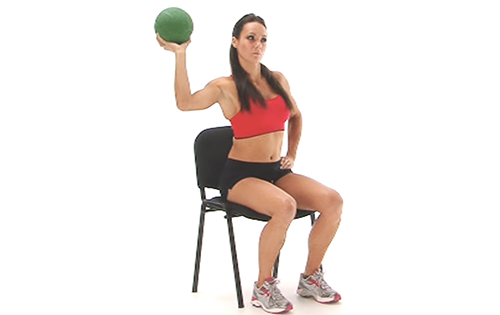
Teaching point:
- Start in a seated position, with the arm raised to 90 degrees and the elbow bent
- The athlete catches the ball as thrown by the therapist and immediately throws the ball back, maintaining the elevated arm position
Extension In Prone With Dumbbell
Shoulder Extension in a prone lying position (on the front) to strengthen the posterior shoulder muscles, the downward rotators, and extensors of the scapula and shoulder joint.
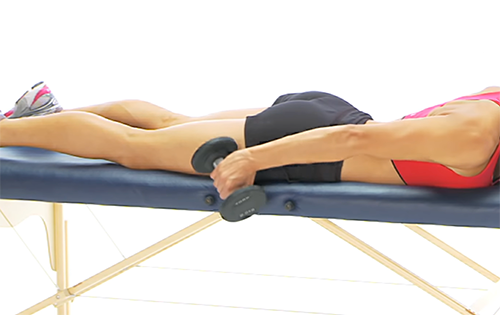
Teaching point:
- The athlete lies on the table with the shoulder over the edge
- Keeping the scapula depressed the athlete moves the arm and weight into full hyperextension at the shoulder
Scapula Upwards Rotation
This exercise works to strengthen the scapula rotators and the downward rotators of the scapula. This exercise targets the rhomboids and lower fibres of trapezius muscles.
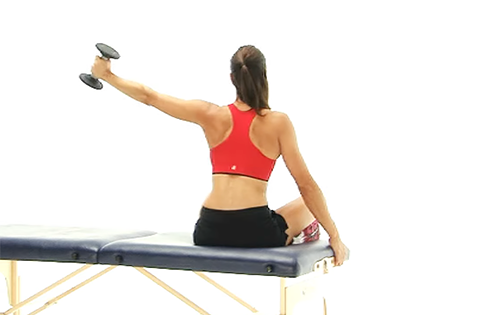
Teaching point:
- With a weight in the hand and thumb facing forwards, the athlete raises the arm, at a 45-degree angle to the body
- The arm is lifted as high as the position, ensuring the shoulders are not shrugged upwards, before slowly returning to the starting position
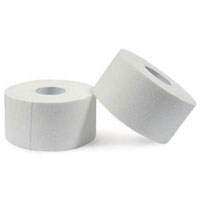
Zinc Ocide Sports Tape
Scapula Pull Down
This exercise strengthens the scapular depressors using a resistance band. This exercise targets the rhomboids and lower
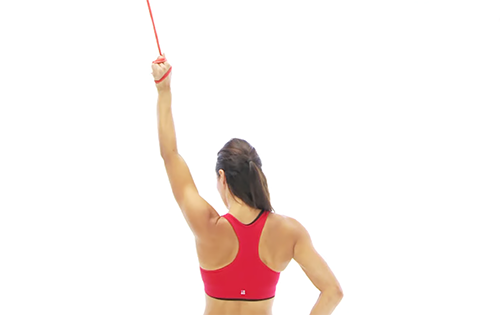
Teaching point:
- Keep the shoulder and elbow joints in their start positions throughout the exercise
- The athlete depresses the scapula down the back as far as possible and returns to the starting position
Bilateral Extension
Bilateral Extension using a resistance band to strengthen the scapula muscles. The aim of this shoulder exercise is to increase mobility and strengthen downward rotators and extensors of the scapula.
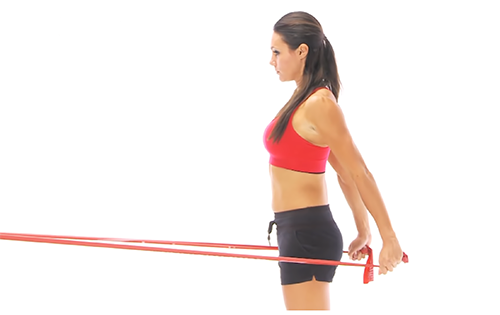
Teaching point:
- The Athlete holds both ends of a band at hip height with the elbows straight and palms facing inwards
- Starting just in front of the body, pull the arms backwards, keeping the elbows straight and squeezing the shoulder blades together and down
External Rotation Retraction
This exercise strengthens the rhomboids and middle trapezius. A resistance band is required for this exercise.
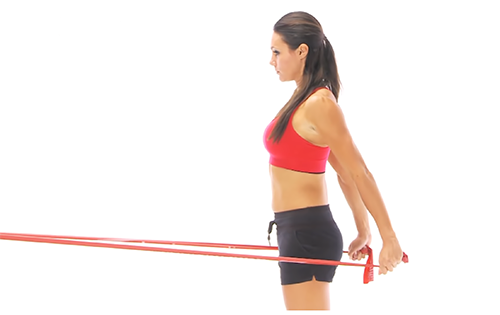
Teaching point:
- With the arms by the sides and the elbows bent, the athlete holds a resistance or elastic band between their hands with the palms facing up
- Move the hands apart to rotate the shoulders, whilst squeezing the shoulder blades together and down the back
- Hold the end position for 2 seconds
- Complete 3 sets consisting of 8-12 reps
Front Raise
This Front Raise requires a resistance band and is designed to strengthen the front of the shoulder. This exercise works the anterior deltoid muscles.
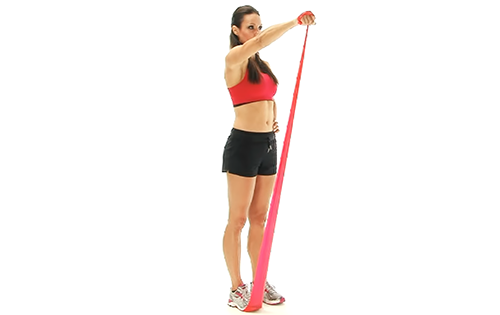
Teaching point:
- The Athlete stands with legs shoulder-width apart, placing one end of the elastic band under one foot
- Change foot position to adjust resistance holding the other end of the band with the hand
- Keeping your elbows straight, raise your arm in front of your torso until your arm raises just above shoulder height
Similar exercises:
- Extension in prone position
- Hands up robbery
Prone Fly Shoulder
The Prone Fly shoulder exercise strengthens the rhomboids and the middle trapezius.
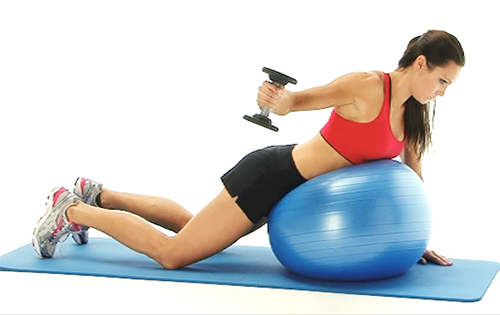
Teaching point:
- The Athlete is on their front over a table or gym ball and raises the arms back while squeezing the scapulae or shoulder blades.
- Perform in a controlled manner and repeat 5 to 10 times per set.
Lateral Rotation Front Lying
The Lateral (external) Rotation exercise strengthens the rotator cuff muscles. This exercise also strengthens the teres minor, infraspinatus, and posterior deltoid.
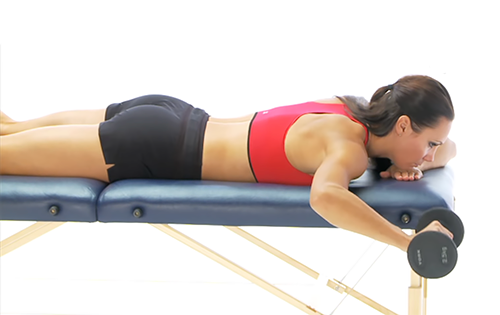
Teaching point:
- Laying on their front (prone) with the arm out to the side and elbow bent as shown
- The athlete rotates the shoulder to lift the weight towards the ceiling as far as is comfortable
Lateral Rotation In Standing
This exercise uses a resistance band and targets the teres minor, infraspinatus, and posterior deltoid muscles. This is a very common shoulder rehabilitation exercise and an easy one to get started with.
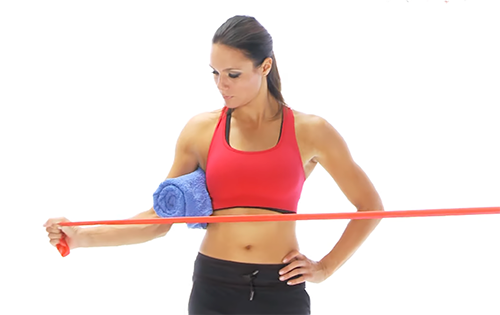
Teaching point:
- The athlete stands holding the band with the elbow abducted at 90 degrees
- They rotate the shoulder outwards as far as is comfortable and return to the centre
- This exercise must be done under control and pain-free
Lateral Rotation Band Abduction
This Lateral Rotation exercise strengthens the rotator cuff and scapular muscles
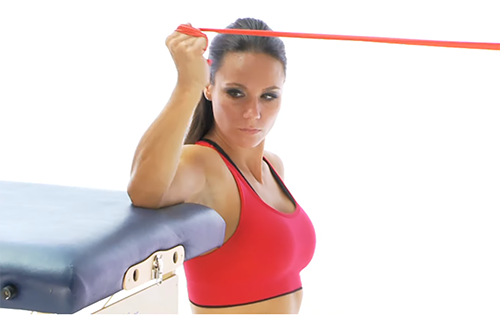
Teaching point:
- The athlete sits with the upper arm supported and the elbow bent to a right angle as shown
- The arm is rotated so that the first points to the ceiling
- This exercise can be made more challenging by removing the support of the couch
Lateral Rotation In Abduction
This exercise uses a resistance band and is also known as the External Rotation in standing. This exercise strengthens the teres minor, infraspinatus, and posterior deltoid.
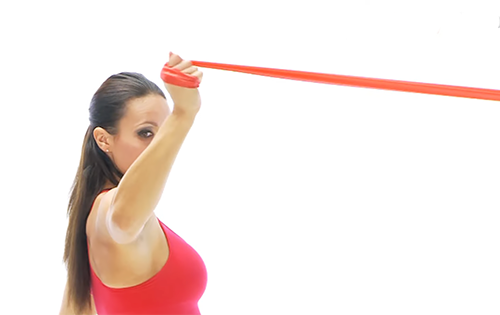
Teaching point:
- The athlete stands holding the band with the elbow abducted at 90 degree
- The athlete elevates the arm, ensuring the elbow is also elevated
- The shoulder is maintained at 90-degree abduction without horizontal adduction or abduction
